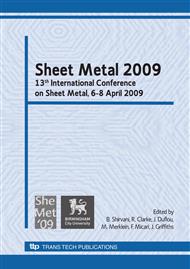[1]
R. von Mises: Mechanik der plastischen Formanderung von Kristallen. Z. Angew. Math. Mech. 8 (1928) p.161.
DOI: 10.1002/zamm.19280080302
Google Scholar
[2]
R. Hill: A theory of the yielding and plastic flow of anisotropic metals. Proc. Royal Soc. London A 193 (1948), p.281.
Google Scholar
[3]
W.F. Hosford: A generalized isotropic yield criterion. J. Appl. Mech. Trans. ASME 39 (1972), p.607.
DOI: 10.1115/1.3422872
Google Scholar
[4]
W.F. Hosford: On yield loci of anisotropic cubic metals. In: Proceedings of the Seventh North American Metalworking Conference, Dearborn (1979), p.191.
Google Scholar
[5]
F. Barlat, J. Lian: Plastic behaviour and stretchability of sheet metals. Part I: a yield function for orthotropic sheets under plane stress conditions. Int. J. Plasticity 5 (1989) p.51.
DOI: 10.1016/0749-6419(89)90019-3
Google Scholar
[6]
F. Barlat, D.J. Lege, J.C. Brem: A six-component yield function for anisotropic materials. Int. J. Plasticity 7 (1991) p.693.
DOI: 10.1016/0749-6419(91)90052-z
Google Scholar
[7]
F. Barlat, R.C. Becker, Y. Hayashida, Y. Maeda, M. Yanagawa, K. Chung, K., J.C. Brem, D.J. Lege, K. Matsui, S.J. Murtha, S. Hattori: Yielding description for solution strengthened aluminium alloys. Int. J. Plasticity 13 (1997), p.385.
DOI: 10.1016/s0749-6419(97)80005-8
Google Scholar
[8]
F. Barlat, J.C. Brem, J.W. Yoon, K. Chung, R.E. Dick, D.J. Lege, F. Pourboghrat, S.H. Choi, E. Chu: Plane stress yield function for aluminium alloy sheets-part I: theory. Int. J. Plasticity 19 (2003), p.1297.
DOI: 10.1016/s0749-6419(02)00019-0
Google Scholar
[9]
F. Barlat, J.W. Yoon, O. Cazacu: On linear transformations of stress tensors for the description of plastic anisotropy. Int. J. Plasticity 23 (2007), p.876.
DOI: 10.1016/j.ijplas.2006.10.001
Google Scholar
[10]
D. Banabic, H. Aretz, D.S. Comsa, L. Paraianu: An improved analytical description of orthotropy in metallic sheets. International Journal of Plasticity 21 (2005), p.493.
DOI: 10.1016/j.ijplas.2004.04.003
Google Scholar
[11]
D. Banabic, T. Kuwabara, T. Balan, D.S. Comsa, D. Julean: -onquadratic yield criterion for orthotropic sheet metals under plane-stress conditions. International Journal of Mechanical Sciences 45 (2003), p.797.
DOI: 10.1016/s0020-7403(03)00139-5
Google Scholar
[12]
H. Vegter, Y.G. An, Y., H. Pijlman, J. Hue´tink: Advanced mechanical testing on aluminium alloys and low carbon steels for sheet forming. In: Gelin, J.C., Picart, P. (Eds. ), Proceedings NUMISHEET 99 (1999), p.3.
Google Scholar
[13]
H. Vegter, A.H. van den Boogaard: A plane stress yield function for anisotropic sheet material by interpolation of biaxial stress states. International Journal of Plasticity 22 (2006), p.557.
DOI: 10.1016/j.ijplas.2005.04.009
Google Scholar
[14]
G.I. Taylor: Plastic strain in metals. J. Inst. Metals 62 (1938), p.307.
Google Scholar
[15]
J.F. W. Bishop, , R. Hill: A theory of the plastic distortion of a polycrystalline aggregate under combined stresses. Philos. Mag. 42 (1951), p.414.
Google Scholar
[16]
J.F. W. Bishop, R. Hill: A theoretical derivation of the plastic properties of a facecentred metal. Philos. Mag. 42 (1951), p.1298.
Google Scholar
[17]
P. Van Houtte: A comprehensive mathematical formulation of an extended Taylor- Bishop-Hill model featuring relaxed constraints, the Renouard-Wintenberger theory and a strain rate sensitivity model. Texture Microstruct. 8-9 (1988), p.313.
DOI: 10.1155/tsm.8-9.313
Google Scholar
[18]
P. Van Houtte, S. Li, M. Seefeldt, L. Delannay: Deformation texture prediction: from the Taylor model to the Advanced Lamel model. Int. J. Plasticity 21 (2005), p.589.
DOI: 10.1016/j.ijplas.2004.04.011
Google Scholar
[19]
H.J. Bunge: Some applications of the Taylor theory of polycrystal plasticity. Krist. Tech. 5 (1970), p.145.
Google Scholar
[20]
P. Van Houtte, K. Mols, A. Van Bael, E. Aernoudt: Application of yield loci calculated from texture data. Texture Microstruct. 11 (1989), p.23.
DOI: 10.1155/tsm.11.23
Google Scholar
[21]
P. Van Houtte, A. Van Bael, J. Winters: The incorporation of texture-based yield loci into elastoplastic finite element programs. Texture Microstruct. 24 (1995), p.255.
DOI: 10.1155/tsm.24.255
Google Scholar
[22]
P. Van Houtte, A. Van Bael: Convex plastic potentials of 4th and 6th rank for anisotropic materials. Int. J. Plasticity 20 (2004), p.1505.
DOI: 10.1016/j.ijplas.2003.11.005
Google Scholar
[23]
F. Grytten, B. Holmedal, O.S. Hopperstad and T. Borvik: Evaluation of identification methods for YLD2004-18p, Int. J. Plasticity 24 (2008), p.2248.
DOI: 10.1016/j.ijplas.2007.11.005
Google Scholar
[24]
P. Van Houtte, S. Jumar Yerra, A. Van Bael: The facet method; a hierarchic al multilevel modelling scheme for anisotropic convex plastic potentials, Int. J. Plasticity 25 (2009), p.332.
DOI: 10.1016/j.ijplas.2008.02.001
Google Scholar
[25]
O. Engler, Y.G. An: Correlation of texture and plastic anisotropy in the Al-Mg alloy, Solid State Phenomena Vol. 105 (2005) p.277.
DOI: 10.4028/www.scientific.net/ssp.105.277
Google Scholar
[26]
Y. G, An, E. Atzema, M. Workel, H. Vegter, L. Elliott, J. Moerman; A comparison of yield loci measured with mechanical tests and calculated from crystal plasticity for steel sheets, 1st International Conference on Super-high Strength Steels (2005).
Google Scholar
[27]
P. S. Bate, Y.G. An: Plastic anisotropy in AA5005 Al-1Mg: predictions using crystal plasticity finite element analysis, . Scritpa Materialia, 51 (2004), p.973.
DOI: 10.1016/j.scriptamat.2004.07.018
Google Scholar
[28]
P. Van Houtte: The 'MTM-FHM', software system Version 2, Katholieke Universiteit Leuven, Belgium, (1995).
Google Scholar
[29]
Y.G. An, H. Vegter: The difference in plastic behaviour between bulging test and through thickness compression test for sheet steels and aluminium alloys. IDDRG Working Group Meeting, 1998, Genval, Belgium.
Google Scholar
[30]
Y.G. An, H. Vegter: Analytical and experimental study of frictional behaviour in through-thickness compression test, Journal of Material Processing Technology, 160 (2005), p.148.
DOI: 10.1016/j.jmatprotec.2004.05.026
Google Scholar
[31]
Y.G. An, H. Vegter, L. Elliott: A novel and simple method for the measurement of plane strain work hardening, Journal of Materials Processing Technology, 155-156 (2004) p.1616.
DOI: 10.1016/j.jmatprotec.2004.04.344
Google Scholar
[32]
Y.G. An, H. Vegter, J. Heijne; Development of simple shear test for the measurement of work hardening, Journal of Materials Processing Technology, to be published.
DOI: 10.1016/j.jmatprotec.2008.11.007
Google Scholar
[33]
Y. Bergstrom; Dislocation model for the stress-strain behaviour of polycrystalline Fe with special emphasis on the variation of the densities of mobile and immobile dislocations. Materials Science and Engineering 5 (1969), p.193.
DOI: 10.1016/0025-5416(70)90081-9
Google Scholar


